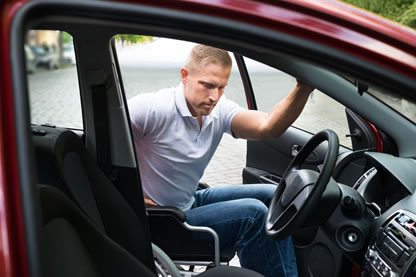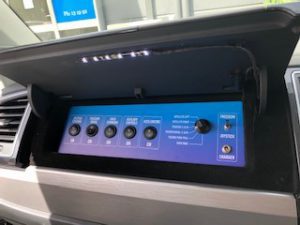Buying a car is a big decision. It’s one of the biggest financial commitments we make throughout our life. And when you’re living with disability it’s even more important to make sure the vehicle you buy suits your individual needs.
Having a clinical assessment with an occupational therapist prior to buying or modifying your car is a great way to ensure you make the most of your purchase. Occupational therapists (often shortened to “OTs”) are healthcare professionals who work to help people participate in the activities of everyday life.
Planning on driving your vehicle, rather than someone driving it for you? You’ll need to obtain the necessary medical clearance from your doctor and state regulatory authority.
For example, in NSW, Roads and Maritime Services needs a doctor’s medical report so it is ‘fully aware of the condition, and so your doctor can recommend any specific licence restrictions, vehicle modifications or further assessments (for example an Occupational Therapist driving assessment). Your licence will be issued with the relevant conditions added.”
If you’ve never had your licence before you must undergo a driver assessment. The same applies if your functionality levels have changed due to a new or existing disability. An occupational therapist can help you with satisfying your state or territory’s licensing requirements.
They will also work with you to investigate your physical and lifestyle requirements when it comes to driving. They can discuss appropriate modifications with you, your carer or your support worker (if you have one) and your vehicle converter.
Driving assessments
Intend to drive the vehicle yourself? You will also need to undergo a driver assessment with an occupational therapist with specialist driver training. Occupational therapy driving assessments are recognised internationally and take around two to three hours. They contain both off-road and on-road components, usually conducted on separate days.
The off-road assessment includes screening of vision, physical function and cognition. The on-road assessment is conducted with a professional driving instructor in a dual control vehicle and takes around 50 minutes.
Following the tests, your Occupational Therapist will discuss the results with you and the licensing authority. When you are issued your driver’s licence or learner’s permit, it will list any vehicle modifications that you require.
If you are not immediately approved for a licence, you may be able to attend a driver rehabilitation program to help get you on the road. These programs may include:
- Learning to use modified vehicles or adaptive equipment
- Learning new driving techniques to compensate for limited functionality
- Desensitisation programs for people with anxiety or phobias
- Driving test preparation
- Upper limb strengthening for people with high level spinal cord injury
Upon receiving your licence, you will likely be eligible for a disability parking permit also.
Car modifications
If you need vehicle modifications in order to drive these need to be fitted while you have your learner licence and not after. Once you move on from being a learner driver you need to pass a disability driving test to upgrade your licence to a provisional P1 licence.
Your occupational therapist will not only assess your ability to drive. Involving your occupational therapist in buying a specialised vehicle is highly valuable. As mentioned, they will look at what kind of modifications you require. They will assess the transport needs of you and your family, explain your options and make sure you choose the most suitable vehicle modifications.
They can also liaise with your doctors and vehicle converters, help you apply for funding and explain regulations and paperwork.
An occupational therapist’s clinical assessment should take into account all aspects of your transportation requirements. They will not only explore your level of disability, they will discuss your home, the size of your family and the places you frequently visit, among other areas. For example, there is no point in buying a vehicle that is too tall to enter the parking facility at your workplace.
Pre-purchase factors to consider
Along with involving your occupational therapist in buying a specialised vehicle, put significant thought and time into your purchase decision. Some main aspects to consider are:
- Whether you have the physical, cognitive and psychological ability to drive a car
- Your ability to enter and exit a vehicle. Can you transfer? Are there ways to make transferring easier? What is the best way for you to travel safely in your wheelchair?
- Your carer’s needs. Carers should be comfortable and confident with any equipment that they will be required to use
- The size of your family. Your vehicle should have enough seating for everyone
- There are often multiple options available for vehicle modifications. Your occupational therapist should help you find one that you can afford
- Height and weight. Your vehicle and any ramps, lifting or storage equipment should be strong enough to hold you, your wheelchair and any other equipment (such as ventilators) that you carry
- Safety and comfort. Your occupational therapist will help to make your vehicle both safe and comfortable for all your needs. For example, you should not need to bend or tilt your head when using hoists, ramps or other lifting equipment. If you experience seizures there should be a mechanism for your carers to quickly and safely change your position in case of emergency
- Do you regularly travel on dirt roads or over speed humps? Does your garage have a low ceiling? Your occupational therapist will ask you about the kind of terrain you usually travel on. They may even visit your home or workplace to assess any possible obstacles
- Storage space. If you need to travel with extra equipment like walking frames, oxygen bottles or commodes, your vehicle should have space to safely store all your gear
Vehicle modifications
In many cases there are multiple options for vehicle modifications. It is important that you and your carer openly discuss your preferences, and the various costs involved, with your occupational therapist.
After completing a full assessment, the therapist can work with you and your chosen vehicle converter to make sure you get the car and modifications that best suit your requirements.
A vehicle is a long-term investment, so it’s important you consider your current needs as well as the expected changes to your needs over time.
Secondhand vehicles
Many people debate whether to buy a new or used vehicle. Purchasing second-hand is one way to reduce the costs associated with buying a specialised car. However, there are several factors to contemplate when choosing one.
An obvious one is involving your occupational therapist in buying a specialised vehicle – whether used or new. The previous user will have set up the vehicle to meet their needs. Check carefully that it also meets all your personal requirements. An occupational therapist can help you with this. If the vehicle will need further modifications, they and you should discuss options with a vehicle converter and any additional costs should be explored.
Remember to check the age and mileage of the base vehicle, as it may not last as long as a new one. As with any secondhand vehicle, it is wise obtain a roadworthy certificate before purchasing.
Also ensure that any previous modifications are properly installed and meet Australian Standards. A vehicle certifier registered in your state or territory should assess all modifications and issue a certificate of compliance as well as an engineering certification.
Dot your I’s and cross your t’s before heading on the road then you can enjoy driving (or passenger-ing) with confidence.









